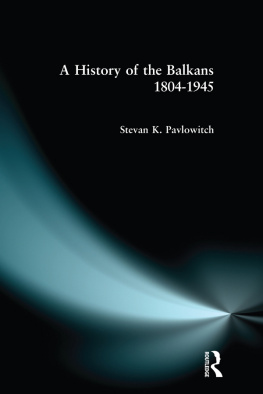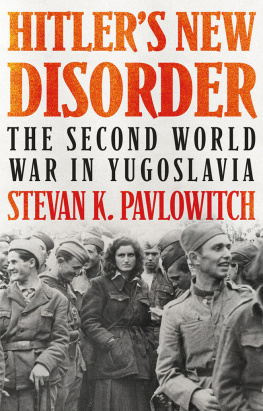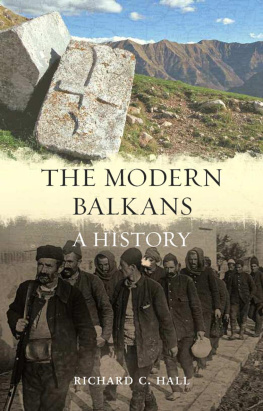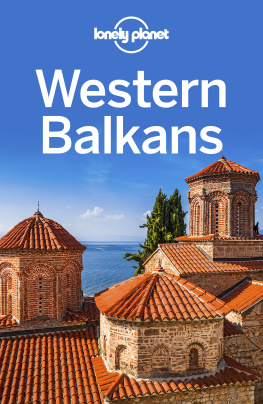First published 1999 Adisson Wesley Longman Limited
Published 2014 by Routledge
2 Park Square, Milton Park, Abingdon, Oxon OX14 4RN
52 Vanderbilt Avenue, New York, NY 10017
Routledge is an imprint of the Taylor & Francis Group, an informa business
Copyright 1999, Taylor & Francis
The right of Stevan K. Pavlowitch to be identified as author of this Work has been asserted by him in accordance with the Copyright, Designs and Patents Act 1988.
All rights reserved. No part of this book may be reprinted or reproduced or utilised in any form or by any electronic, mechanical, or other means, now known or hereafter invented, including photocopying and recording, or in any information storage or retrieval system, without permission in writing from the publishers.
Notices
Knowledge and best practice in this field are constantly changing. As new research and experience broaden our understanding, changes in research methods, professional practices, or medical treatment may become necessary.
Practitioners and researchers must always rely on their own experience and knowledge in evaluating and using any information, methods, compounds, or experiments described herein. In using such information or methods they should be mindful of their own safety and the safety of others, including parties for whom they have a professional responsibility.
To the fullest extent of the law, neither the Publisher nor the authors, contributors, or editors, assume any liability for any injury and/or damage to persons or property as a matter of products liability, negligence or otherwise, or from any use or operation of any methods, products, instructions, or ideas contained in the material herein.
ISBN13: 978-0-582-04584-2 (pbk)
British Library Cataloguing in Publication Data
A catalogue record for this book is available from the British Library
Library of Congress Cataloging-in-Publication Data
Pavlowitch, Stevan K.
A history of the Balkans, 18041945 / Stevan K. Pavlowitch.
p. cm.
Includes bibliographical references and index.
ISBN 0-582-04585-1 (hardcover). ISBN 0-582-04584-3 (pbk.)
1. Balkan PeninsulaHistory19th century. 2. Balkan PeninsulaHistory20th century. I. Title.
DR43.P34 1999
Set by 35 in 10/12pt Bembo
The geography and its impact on the history. Byzantium, the medieval monarchies, the Ottoman conquest and the Habsburg reconquest. The transition of the eighteenth century.
The Balkan peninsula is characterized both by geographical unity and a unity imposed by history. The word Balkanization is often used to mean fragmentation and turbulence, but historians of the peninsula1 have pointed out that its history is no more turbulent than that of any other part of Europe before the First World War. Fragmentation and turbulence are, in any case, the result of its make-up, its place on the map, and the struggle for its control.
The Turkish word balkan means wooded mountains. Unlike the Iberian and Italian peninsulas, the Balkan peninsula is defined by the mountainous mass itself. The Dinaric mountains run from the Alps of Slovenia down the Adriatic coast to Albania, then turn inland as the Pindus range into central Greece, allowing only the most narrow of coasts to the west. The Carpathian chain forms a reverse S that begins north of Romania, goes south to divide the plains of Moldavia and Wallachia from the uplands of Transylvania, before turning southwest to cross the Danube at the Iron Gates, then east through Bulgaria as the Balkan range proper. Finally, the ancient Macedonian and Thracian land mass thrusts fingers into northern Greece.
The discontinuous structure of these mountains has discouraged integration from within, but has formed no barrier to penetration. Connected valleys, plateaux and basins have provided access. They have fostered particularities and connexions, conquests and exchanges. The most important passageways have been the Danube and the Belgrade-Salonika road forming between them a huge T-shaped interchange. While the great river has been a link to central Europe and to Russia, a vital road runs through depressions in the ancient land mass from the Danubian plains, by way of the Morava and Vardar valleys, to the Aegean.
The lasting influences came from the open north or from the south by the Eurasian link, and followed the north-south routes. The Romans conquered most of the Balkans, but did not settle except along the Adriatic coast and the Danube. By the beginning of the sixth century, there were two mainly urban linguistic areas Roman north and west, Greek south and east. The Romanized zone comprised a coastal Adriatic and a Danubian bloc, separated by a more lightly Romanized mountainous interior, with a mixed zone fading into the Hellenized south.
The South Slavs, who had come from north of the Carpathians in the wake of the migrations originating from the central Asian steppes, then crossed the Danube. They swept over the Balkans from the Alps to the Peloponnese, completely modifying the ethnic structure of the peninsula as they settled. The natives Hellenized, Romanized or otherwise withdrew to mountain, coastal and island retreats, or were absorbed by the newcomers, who were themselves assimilated the further they penetrated into Greek lands.
Eventually a broad middle belt from the Adriatic to the Black Sea was Slavicized. The general name Slovene stuck to frontier populations where there was a distinct contrast with non-Slavs. Old names of leading tribes spread to those who had settled from the western plains to the Adriatic Croat and to those along the southern tributaries of the Danube and in the depressions Serb. Germanic, Slav and Greek populations applied the name Vlach (variants such as Welsh and Walloon were used elsewhere), which may have come from a Romanized Celtic group, to the Romanized in their midst, but also to others who had a similar way of life.
A first effort at Christianization had been interrupted by the invasions. The further conversion of the Slavs by the overlapping influences of the papacy and of Byzantium led to the Latin variant prevailing in the west, with Greek forms in their vernacular adaptation spread well beyond the Hellenic cultural sphere by Byzantine missionaries.
The confusion resulting from the onslaught of new populations, followed by changes in the west, enabled South Slav feudal organizations to emerge in the interstices between the Byzantine Roman Empire in the east and the successive claimants to the Roman inheritance in the west. Originating from beyond the Sea of Azov, the Bulgars were encamped on both sides of the Danube by the ninth century. They were assimilated by the local Slavs, but not before they had given them their name and an organization, and welcomed Christian missionaries. The peak of their realm came when their ruler Simeon assumed the title of tsar (Caesar), as he tried to take Constantinople in 925. The Bulgarian Empire subsequently raised tribute from territories that ranged, at one time or another, from the Danube to the northern Greek lands and to the Adriatic.
To the north, as the Magyars or Hungarians settled in the Pannonian plains and adopted Christianity, feudalism was carried out under Germanic rule in the Slovene lands, but a native development emerging out of Slav tribal structures enabled a Croatian realm to dominate the roads from the northern Adriatic to the plains. The crown that King Tomislav secured from the pope in 925 (at the same time as Simeon become tsar) came into the possession of the king of Hungary in 1102. This was when Hungary also first acquired control of Transylvania, an upland territory within the arc of the Carpathians with a mixed but probably basically Romanized population, which retained, like Croatia, an autonomous position.












